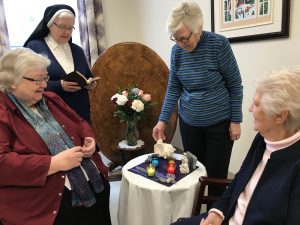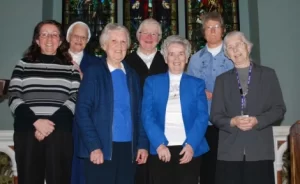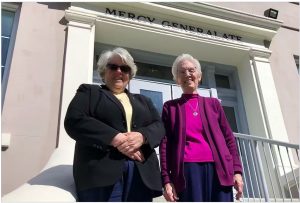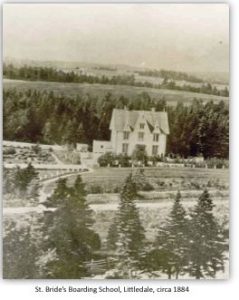ABSTRACT
 Although she denies it, Sister Elizabeth Davis, a member of the Congregation of the Sisters of Mercy of Newfoundland and Labrador, is becoming a Canadian icon: in education, in healthcare, in leadership development, in social policy and in religious studies, in Canada and abroad. With teaching appointments and participation on many boards and commissions, she leaves a trail of wisdom, quiet successes and vocal fans in her wake. In 2001, she won the Catholic Health Care Association of Canada’s Performance Citation Award and the Canadian Healthcare Association’s Award for Excellence in Distinguished Service. Those were followed by an Honorary Doctor of Laws from Memorial University of Newfoundland, induction into the Alpha Sigma Nu Honour Society of Jesuit Educational Institutions and an appointment as a Member of the Order of Canada in 2004. Recently, the University of Toronto’s Department of Health Policy, Management and Evaluation selected Sister Elizabeth as Leader of the Year for 2006. Ken Tremblay caught up with Sister Elizabeth at St. Augustine’s Seminary in Toronto, where she is currently teaching a course titled Introduction to the Old Testament.
Although she denies it, Sister Elizabeth Davis, a member of the Congregation of the Sisters of Mercy of Newfoundland and Labrador, is becoming a Canadian icon: in education, in healthcare, in leadership development, in social policy and in religious studies, in Canada and abroad. With teaching appointments and participation on many boards and commissions, she leaves a trail of wisdom, quiet successes and vocal fans in her wake. In 2001, she won the Catholic Health Care Association of Canada’s Performance Citation Award and the Canadian Healthcare Association’s Award for Excellence in Distinguished Service. Those were followed by an Honorary Doctor of Laws from Memorial University of Newfoundland, induction into the Alpha Sigma Nu Honour Society of Jesuit Educational Institutions and an appointment as a Member of the Order of Canada in 2004. Recently, the University of Toronto’s Department of Health Policy, Management and Evaluation selected Sister Elizabeth as Leader of the Year for 2006. Ken Tremblay caught up with Sister Elizabeth at St. Augustine’s Seminary in Toronto, where she is currently teaching a course titled Introduction to the Old Testament.HQ: Sister, your life with the Sisters of Mercy has been anything but traditional. From early roots in education, to healthcare leadership, to lifelong learning and doctoral studies, from small-town Newfoundland to international venues, from issues in contemporary society to religious studies of the Old Testament, from shaping minds to shaping policy and planning the future of a province, conversations with your general superior must be interesting?Sister: [Chuckle] To say the least! The sisters have been very supportive of me and my career. They have congratulated me on many occasions, and they constantly challenge me to do more. You might think that they would say “stick to the knitting” and stop wandering. They have recognized that these vocational changes have been important to me. I have been very fortunate to have accumulated these experiences and been grounded in their diversity.
HQ: What has been your proudest moment?
Sister: Actually, I have never thought of that. I guess, in a paradoxical way, it was the experience in St. John’s. Here we were, arguably in Canada’s poorest province, making significant changes in the way we delivered care. Staff in 10 different organizations joined me in making the decisions that were in the best interest of healthcare, and they put those needs ahead of their own interests – the unions, physicians, staff members, managers, volunteers, board members. Witnessing that degree of commitment – people putting aside their personal interests in the best interest of the community, during a very difficult time – was witnessing a triumph of the human spirit. I was proud to be counted among them.
Author: Ken Tremblay. Source: Healthcare Quarterly 10(1) January 2007 : 30-32.doi:10.12927/hcq..18646
Read the complete article here (PDF)


 Each Sunday in Advent, Sr. Elizabeth Davis and her fellow Mercy sisters light a candle on their cosmic Advent wreath adorned with shells, pinecones, rocks and colorful ribbons.
Each Sunday in Advent, Sr. Elizabeth Davis and her fellow Mercy sisters light a candle on their cosmic Advent wreath adorned with shells, pinecones, rocks and colorful ribbons.  Her love for all humanity was not confined to her choral work. She has been a tireless advocate of the dignity of the homeless, the poor, and the physically and mentally frail. She initiated a multi-faith committee that crossed denominational boundaries to spearhead the distribution of food and clothes to the less fortunate in the City of St. John’s.
Her love for all humanity was not confined to her choral work. She has been a tireless advocate of the dignity of the homeless, the poor, and the physically and mentally frail. She initiated a multi-faith committee that crossed denominational boundaries to spearhead the distribution of food and clothes to the less fortunate in the City of St. John’s. The purpose of this study was to trace the work of the sisters of Mercy in Newfoundland in the field of business education. The Sisters began their work in the late 1800’s, when they first introduced business education courses into the curriculum of their convent schools. Their work continued until the mid-1900’s, when they began phasing out the formal business education programs which they had developed over the years in their schools. Their activities in this area constitute an important and lasting contribution to the field of business education. There has been no previous in-depth scholarly investigation into this aspect of the Sisters’ work. Therefore, a study of the Sisters’ contribution to this field is long overdue.
The purpose of this study was to trace the work of the sisters of Mercy in Newfoundland in the field of business education. The Sisters began their work in the late 1800’s, when they first introduced business education courses into the curriculum of their convent schools. Their work continued until the mid-1900’s, when they began phasing out the formal business education programs which they had developed over the years in their schools. Their activities in this area constitute an important and lasting contribution to the field of business education. There has been no previous in-depth scholarly investigation into this aspect of the Sisters’ work. Therefore, a study of the Sisters’ contribution to this field is long overdue.

 Since 1842, the Sisters of Mercy had been ministering to the sick, poor and needy of St. John’s, thus when this established tradition of care was redirected toward hospital patients it was not difficult for St. Clare’s to live up to the motto “Mercy Above All.” Accordingly, St. Clare’s became home to Newfoundland’s first alcohol and detoxification centre and its first palliative care unit, and absorbed the chronic care of tuberculosis patients following closure of the city’s sanatorium; from 1922 until the obstetrics unit closed 70 years later, 83 000 babies were delivered…”
Since 1842, the Sisters of Mercy had been ministering to the sick, poor and needy of St. John’s, thus when this established tradition of care was redirected toward hospital patients it was not difficult for St. Clare’s to live up to the motto “Mercy Above All.” Accordingly, St. Clare’s became home to Newfoundland’s first alcohol and detoxification centre and its first palliative care unit, and absorbed the chronic care of tuberculosis patients following closure of the city’s sanatorium; from 1922 until the obstetrics unit closed 70 years later, 83 000 babies were delivered…” At this time St. Bride’s College, Littledale, established in 1884 by the Sisters of Mercy as a boarding school for young women interested in the teaching profession, was becoming increasingly important in the educational and cultural life of Newfoundland. The need for highly qualified teachers for Littledale was a constant concern for the bishop. Consequently, he was quick to welcome Sarah to the diocese, not for the Presentation Sisters but for the Sisters of Mercy.
At this time St. Bride’s College, Littledale, established in 1884 by the Sisters of Mercy as a boarding school for young women interested in the teaching profession, was becoming increasingly important in the educational and cultural life of Newfoundland. The need for highly qualified teachers for Littledale was a constant concern for the bishop. Consequently, he was quick to welcome Sarah to the diocese, not for the Presentation Sisters but for the Sisters of Mercy.
